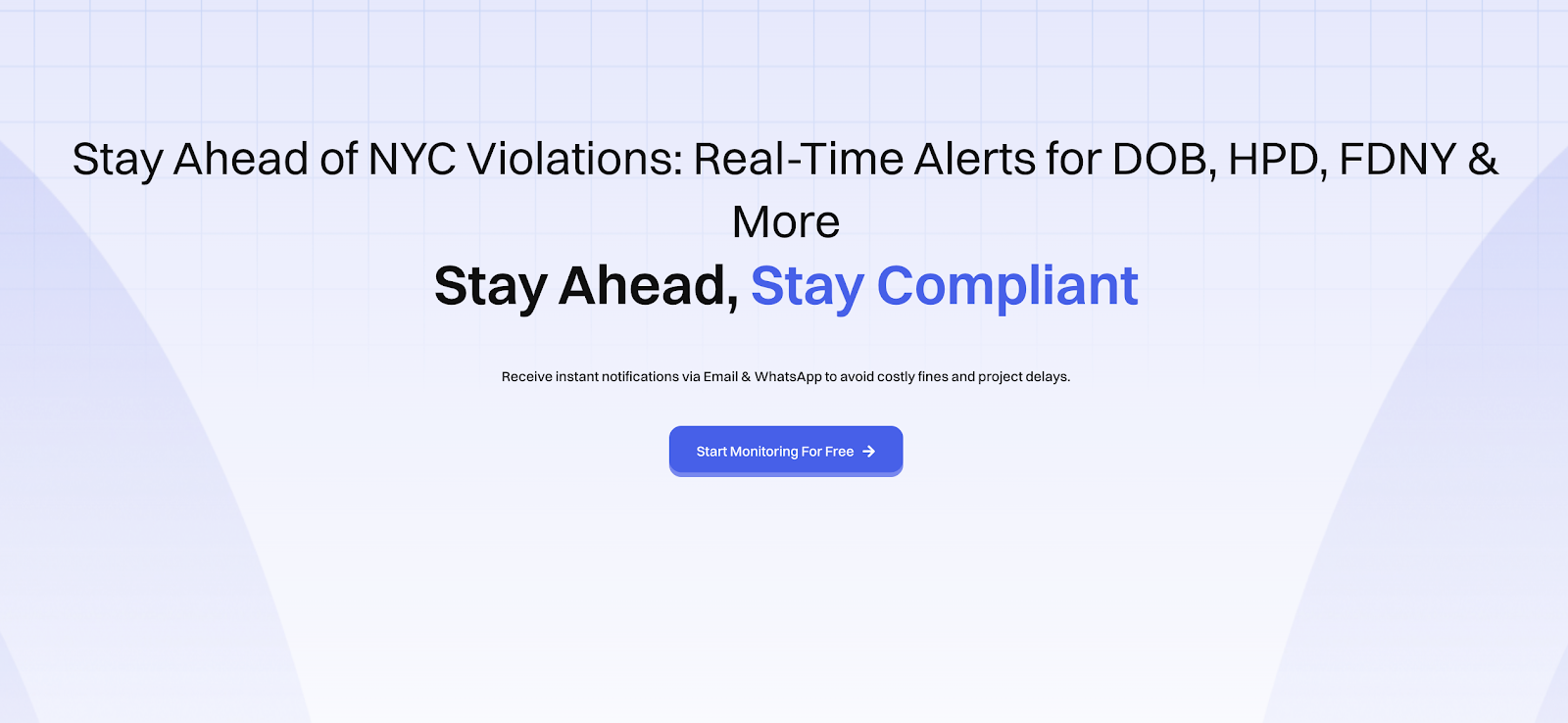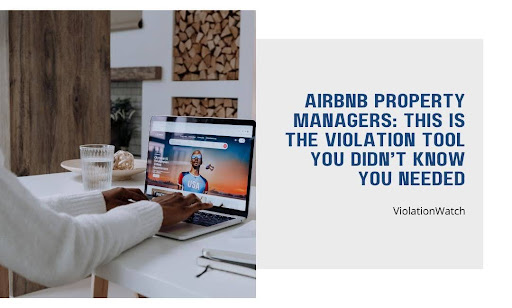You stay booked. The reviews glow. But one HPD violation, one missed ECB hearing—and the whole operation can spiral. That’s the trap.
Running short-term rentals in NYC isn’t just about keeping guests happy. It’s about keeping the city off your back. DOB. FDNY. HPD. DEP. Each one can hit you with a fine or a stop-work order before you even realize you’re on their radar. Most Airbnb managers don’t track violations until they’re forced to. By then, the damage is already done.
Here’s the truth most people miss: violation risk isn’t just part of the business—it’s the part that can shut you down. And the old way of tracking violations—spreadsheet tabs, buried PDFs, late-night 311 searches—can’t keep up with the pace of enforcement in this city.
You need a smarter system. One that catches every new violation. One that keeps everything centralized, searchable, and actionable. And yes, it needs to scale whether you manage one unit in Harlem or fifty across Brooklyn.
In this article, we’ll break down what that system looks like:
- A unified dashboard that shows all violations across DOB, HPD, ECB, FDNY, and more—no agency hopping
- Instant alerts when new violations hit or hearings approach
- Smart reporting tools that help you catch issues before they grow
- Built-in document storage so you stop chasing files across email threads
- Access to compliance experts when a violation gets tricky or urgent
- Flexible scaling from single listings to large portfolios
- Streamlined resolution workflows that actually help you close violations and cut fines
If you stack these features side by side and ask, “What NYC tool offers all of this?”—you’ll land in one place: ViolationWatch.
One Screen That Shows You Everything You Need
Keeping track of NYC violations isn’t hard because the data is hidden. It’s hard because it’s scattered.
DOB reports live in one place. HPD issues stack up somewhere else. ECB hearings? Different portal. FDNY orders? Another site, another login. That’s four tabs—and you’re only covering half the risk.
This is where most systems fall apart. You can’t make fast decisions if you’re wasting hours stitching information together. The time lost adds up. So do the missed deadlines, overlooked notices, and double-entry mistakes.
What you need is one place that shows everything. No toggling. No guesswork. No outdated spreadsheets. A single view that covers:
- Open violations from every agency tied to your properties
- Details like status, issue date, location, and description
- Compliance deadlines and hearing schedules
- Historical data for audits or dispute defense
When you centralize this kind of data, you move faster. You see the risk early. You plan repairs before fines escalate. You stop problems before they spread across your portfolio.
It also opens the door for clear communication between property managers, legal teams, and operations staff. Everyone works from the same data—no missteps, no mixed messages, no digging for answers.
Instead of reacting to a violation two weeks late, you’re already on top of it—because it showed up in your dashboard the day it hit the system. This is what lets professionals scale. Not bigger teams. Not more assistants. Better visibility.
Stay Ahead of Fines With Instant Violation Alerts
City agencies don’t wait. When a violation is issued or a hearing date gets locked in, the countdown starts. But here’s the problem—you often don’t find out until it’s too late.
Maybe the notice went to an outdated address. Maybe it got buried in a pile of unrelated mail. Maybe no one even knew it existed until the penalties started stacking up. That’s where instant alerts change everything.
You don’t need to guess. You don’t need to search. The moment a new violation hits—or a hearing gets scheduled—you get a direct ping. Straight to your phone, email, or even your WhatsApp Business number. The goal is speed. Not scrambling.
Here’s what that looks like in practice:
- You get notified immediately when an agency posts a new violation
- Upcoming hearings don’t sneak up—you see them before they cause damage
- Critical updates land where you’ll actually see them, not in a dashboard you forgot to check
- You can act fast, pull the paperwork, schedule repairs, or prep defense without delay
It’s a simple system. But it protects your entire operation. One missed alert can cost thousands. A well-timed one can save the business.
Stop Wasting Time Hunting Down Docs

The clock’s ticking. A contractor needs the violation notice. Your attorney’s asking for the inspector’s photos. HPD wants proof of correction—and your inbox? It’s a mess.
This happens more than it should. One team uploads something to Drive. Another person emails a scanned copy. Someone else has it saved to their desktop. When the pressure’s on, you don’t have time to dig through threads, folders, or file names that don’t make sense.
Here’s how built-in document storage fixes it:
- Upload once. Access from anywhere. All violation-related docs—photos, affidavits, letters, permits—live in one secure place tied directly to each case.
- Skip the inbox search. Attachments don’t get buried in email chains or lost in group chats.
- Share without delay. Forward docs to your legal team or contractors in seconds. No downloading, renaming, or re-uploading.
- Track what’s missing. See at a glance what’s been uploaded and what still needs to be added.
This isn’t about fancy file organization. It’s about control. About saving hours on admin tasks you shouldn’t have to repeat.
When every document is where it belongs—and tied to the right violation—you don’t fall behind. You move forward. Fast.
When the Violation Isn’t Straightforward
Some violations are simple. Fix the issue. Submit the proof. Move on. Others? Not so much.
You get a confusing notice with vague wording. Or two agencies issue overlapping orders. Or the hearing date is three days out, and you have no idea what paperwork is missing. That’s where most tools fall short. Tracking alone isn’t enough when things get messy.
What actually helps? A human who knows the playbook.
Someone who’s worked with DOB, HPD, or ECB. Someone who’s helped reduce fines, resolve conflicts, and get owners through hearings without extra drama. You don’t need to “figure it out.” You need clear steps. Fast answers. Real support from people who handle this stuff every day.
Let’s make that painfully clear:
- No more vague agency emails.
- No more guesswork on paperwork.
- No more last-minute scrambling.
You’ve got someone to call. And they don’t deal in theory—they deal in solutions.
Built to Fit One Listing or a Hundred
Whether you’re running a walk-up in Queens or handling dozens of short-term units across the boroughs, your violation system needs to adapt, not slow you down.
A system that scales is more than a convenience—it’s the backbone of staying compliant without draining your time or team.
Start Small Without Limitations
If you’re managing one or two Airbnb units, you don’t need an enterprise setup with bloated features. What you need is:
- Clear visibility over each address
- Alerts that hit your phone before the city hits your wallet
- Simple tracking tools that don’t require training or tech support
The key is to ensure consistency—from your first check-in to your final check-out—so that nothing slips through the cracks and every violation is tracked before it turns into a fine or suspension.
You don’t need to memorize the fine print buried in agency notices. You need clear workflows and systems that let you focus on your listings, not backend chaos.
Scale Up Without Losing Control
More properties mean more violations. More hearings. More paperwork. More people involved. That’s where most tools fall apart—when growth turns software into a slowdown.
With the right structure in place, you get:
- Portfolio grouping by neighborhood, building, or ownership structure
- User access levels for different team members (contractors, legal, admin)
- Dashboard filters that surface what matters, without noise
- Custom views to isolate high-risk properties or open violations at scale
The faster you grow, the more it matters that your internal systems match your outward appearance. That includes making sure every unit stays guest-ready with fresh linens, no last-minute notices, and no violation issues that creep in from the unit next door.
What That Means in Practice
Fewer operational hiccups. Fewer tenant surprises. More five-star experiences. That’s how you earn good reviews—and eventually, great reviews—from guests who feel like your operation is dialed in.
It also means staying protected. With built-in compliance workflows and documentation, you lower the risk of avoidable violations and lean into host damage protection features when needed—without relying on vague support threads buried in Facebook groups or blog posts from advertising companies.
If a red flag pops up, you catch it early. If a unit runs smoothly, it reflects in your search results. And if a guest has a negative experience, it won’t be because you missed a deadline tied to Airbnb’s terms. Growth doesn’t need to mean hope—it needs to mean confidence. Confidence that your backend is as clean as your bed setup.
Getting It Resolved Without Getting Buried
A violation isn’t “handled” just because it’s listed on your dashboard. The real work starts after the alert. And it’s not always clear what steps to take—or in what order.
That’s where most Airbnb managers stall out. They know there’s a fine. They know there’s a deadline. But what exactly needs to be filed? Who signs what? Which agency requires physical proof, and which accepts digital submission?
Cut the Guesswork With Step-by-Step Support
A streamlined resolution flow gives you structure. No loose ends. No duplicated work.
Instead, you get:
- A clear task list based on violation type and agency
- Required documentation pre-mapped to each task
- Auto-reminders for deadlines that actually impact your case
- Upload fields tied to specific correction steps
You move through it like a checklist, not a scavenger hunt.
Minimize Penalties With Faster Action
Every day a violation stays open risk increases. Faster resolution leads to:
- Lower fines
- Fewer repeat inspections
- Less disruption to short-term operations
When your process is locked in and repeatable, you stop spending brainpower on figuring it out and start closing out violations with precision.
How Smart Tech Flags Risk Before You Do

This isn’t about trend-chasing. It’s about getting ahead of violations before they derail your listings. AI isn’t replacing management—it’s replacing guesswork.
It reviews patterns. Scans timelines. Picks up on issues you didn’t even know were forming. Not with hunches, but with historical data, keyword scanning, and real-time system inputs pulled straight from agency sources.
What That Actually Means for You
- A new DOB pattern flagged across similar buildings? You see it.
- Repeated delays in resolving HPD complaints tied to tenant reports? That trend surfaces automatically.
- Are units at higher risk of triggering enforcement based on past infractions? AI groups them without being asked.
It’s predictive. Not reactive. You’re not waiting for the city to show you a problem—you’re spotting it early enough to sidestep it entirely.
Less Firefighting, More Forecasting
The real strength isn’t in flashy features—it’s in how much time you don’t spend putting out fires. You focus on the units that need attention. The ones slipping through the cracks. The ones your staff keeps flagging in Slack but never gets around to addressing.
And the alerts you get? They’re smarter, too. Not spam. Not noise. Actual signals that tie back to agency behavior, property history, and compliance performance. It’s not about trusting a robot. It’s about trusting patterns backed by data you already had—but didn’t have time to process.
Now it works for you. Quietly. Constantly. Reliably.
What You Pay Should Match What You Manage
Pricing shouldn’t feel like a math problem—or a trap. If you manage one property, you shouldn’t pay like you’re running a development firm. If your portfolio grows, your tools should scale with you, not penalize you for success.
What actually makes sense?
- Flat monthly options for small-scale operators who need focused support
- Per-unit pricing tiers that flex as you add or remove listings
- Portfolio plans that reduce per-property cost as volume increases
- Custom quotes for teams managing large footprints or working with compliance partners
No surprise fees. No inflated charges for features you don’t use. No calls from sales teams every time you click “add property.”
And if you’re sharing access with legal, operations, or contractors? Plans should include multi-user functionality without stacking costs.
Here’s what to look for:
| Plan Type | Best For | Key Benefit |
| Starter | 1–2 listings | Simple coverage without bloat |
| Growth | 3–15 listings | Lower per-unit pricing |
| Portfolio | 15+ listings | Full dashboard access + team tools |
| Enterprise | Custom setups, multi-building | Integration support + API options |
You’re not buying software. You’re reducing risk, saving time, and keeping listings active. The price should reflect that, and nothing else.
The Only Platform That Fully Covers Airbnb Violation Risk in NYC

Let’s say you walk into the NYC compliance market today looking for a tool that:
- Tracks every violation across DOB, HPD, ECB, FDNY, DEP, DOH, DOT, DSNY, DEC, and DOF
- Sends instant alerts across WhatsApp, SMS, and email
- Supports real-time tracking of status changes and hearing updates
- Stores all documents per violation, mapped to the issuing agency and timeline
- Uses AI-backed pattern detection to surface high-risk properties before a violation hits
- Offers clear resolution workflows, tied to agency-specific protocol and documentation
- Scales from a single walk-up to a 100-building portfolio
- Lets you segment access by team role—property manager, owner, legal, vendor, operations
That’s not a wishlist. That’s the bare minimum required to keep short-term rental businesses operational in this city without exposing them to compounding fines, vacate orders, or litigation.
Managing listings in NYC also means protecting your Airbnb account from disruptions that trigger penalties—or worse, delisting. A single compliance slip could lead to a bad review tied to operational failure, even when the guest experience was flawless. Try finding one tool that does all of that. You won’t. Unless you’re using ViolationWatch.
This isn’t a piecemeal product. It’s a purpose-built platform designed to manage the actual enforcement structure of NYC housing law—no guesswork, no duct-taped spreadsheets, no third-party API integrations that break mid-quarter. Here’s what separates it:
Full NYC Agency Integration—Not Partial
Many tools say they “track violations.” Most stop at DOB or HPD. ViolationWatch gives you a single-pane dashboard that pulls live data across all enforcement bodies issuing property-related violations—11 total NYC agencies, each with its own standards, violation codes, and escalation timelines. That includes:
- HPD Class B/C complaints
- DOB ECB summonses
- FDNY violation orders
- DEP/DOH/DSNY environmental citations
- DOT sidewalk and curb enforcement
- DOF lien-related notices
- DEC infractions tied to zoning or hazardous materials
Each violation is normalized, categorized, and logged in a way that’s readable, searchable, and export-ready.
Real-Time Violation Alerts That Hit the Right Channel
This isn’t about email alone. ViolationWatch delivers multi-channel violation alerts with zero delay:
- WhatsApp Business integration for team-wide mobile alerts
- Email notifications for formal documentation flow
- Dashboard banners for unresolved alerts
- Violation-level status badges that update as hearings are scheduled or compliance is filed
This level of visibility helps you prevent incidents where a guest breaks house rules due to unresolved safety or access issues—events that directly affect guest reviews and future guests who rely on prior feedback to assess your listing.
Purpose-Built Workflows for Closing Violations—Fast
Each agency has its own process. ViolationWatch has built pre-structured resolution flows that walk users through what to do next, based on violation class, issuing agency, and deadline urgency.
For example:
- HPD Class C heating complaint? File proof of correction and HVS-certified technician form within 24 hours.
- DOB ECB summons? Review hearing schedule, assign legal representation, and upload defense materials ahead of the submission window.
- FDNY Notice of Violation? Upload affidavits of correction, FDNY-specific service documentation, and contractor verification with timestamped submission proof.
When handled properly, these workflows protect search ranking on Airbnb, ensuring compliance issues don’t lead to temporary suspensions that lower visibility among potential guests.
Scalable Infrastructure Built for Property Managers—Not Developers
Whether you’re managing a single Airbnb unit or a decentralized portfolio of 50+ properties:
- Custom groupings let you segment by borough, ownership entity, or legal structure
- Portfolio views show high-risk buildings, violation counts, and unresolved fines at scale
- Multi-user access lets contractors, attorneys, and admins manage their scope without touching unrelated buildings
- Audit logs track who uploaded what, when—critical for defense, hearing prep, or partner accountability
This reduces the chance that violation missteps lead to issues with local governments, which could restrict short-term rental rights. It also helps keep properties guest-ready, with no surprises that interfere with the guest’s stay or violate Airbnb’s rules.
AI-Driven Violation Intelligence Built In
ViolationWatch uses machine learning to scan historical violation patterns across your portfolio and cross-reference with public complaint records and enforcement trends. The system surfaces risk indicators based on:
- Repeat complaints in the same building or address cluster
- Agency enforcement spikes in the same zip code
- Complaint language that typically precedes specific violations (e.g., “illegal lockout” → HPD Class C)
- Missed filing deadlines in similar building types
The goal? Avoid compliance gaps that result in negative review chains caused by unaddressed conditions. If your listing has a quiet hours rule posted but receives a violation for noise or overcrowding, it can quickly escalate, hurting both the Airbnb hosts and the review period for the recent guest.
Pricing That Doesn’t Punish Growth
Plans scale cleanly—no lock-ins, no penalty pricing for extra features:
| Tier | Use Case | Pricing Structure |
| Free | Try with 1 building | $0/month (limited features) |
| Standard | Small-scale operators | $9/month per building |
| Portfolio | 10+ buildings or teams | Volume discount per building |
| Enterprise | Custom portfolios + team roles | Quote-based + API or white-labeling |
You don’t pay extra for alerts. You don’t pay per user. You pay per building, with predictable monthly costs and access to the full feature set, not a stripped-down starter plan.
This clarity in pricing matters. Most hosts managing multiple listings don’t have time to debate which tier includes core compliance features, or chase a partial refund through a manual resolution center when they scale up mid-cycle.
What you get here is straightforward:
- Full access from day one
- Features that adjust as your portfolio expands
- No hidden charges for automation, support, or document uploads
That means fewer billing headaches, more budget predictability, and no guesswork when it’s time to bring on more units or team members. For hosts concerned with maintaining strong Airbnb profiles and consistently earning positive reviews, stable pricing and uninterrupted compliance workflows aren’t just financial advantages—they’re essential to building trust.
When your listings are protected under NYC local laws, properly documented, and handled with real-time oversight, you reduce the risk of disruption that could negatively impact Airbnb reviews, delay bookings, or conflict with Airbnb policy.
Ultimately, what guests expect is consistency. Clean listings. No surprises. No last-minute cancellations. When you keep operations smooth and violations resolved, you’ll spend less time managing guest feedback and more time delivering the experience that makes them encourage guests to leave five stars. ViolationWatch supports both the host and the backend process that keeps your units compliant, active, and aligned with what most guests count on.
Managing Airbnb Violations in NYC Just Got Smarter With the Right Tool
Keeping up with NYC agencies isn’t a paperwork problem. It’s a systems problem. But once you solve it, the pressure shifts.
You’re no longer reacting to violations you missed. You’re spotting them the day they drop. You’re not scrambling through inboxes. You’re sending the right doc to the right agency—on time, every time. And instead of letting one overdue ECB hearing knock a unit offline, you’ve already resolved it before the city follows up.
That’s what the right tool delivers:
- Fewer missed deadlines
- Fewer mounting fines
- Fewer emergency calls to your attorney
- More listings that stay profitable
- More bandwidth to grow your operation, not babysit violations
And when you look at what it takes to actually get those results—a unified dashboard, automated tracking, live alerts, agency-specific workflows, document storage, expert support, and smart pricing—it leads you to one solution built to handle it all: ViolationWatch. The risk hasn’t changed. But how do you handle it? That’s entirely up to you.

